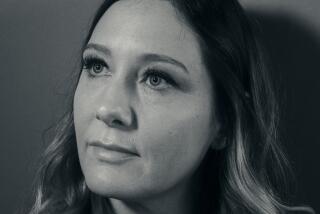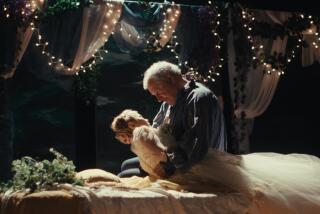Review: Strong performances highlight timely period drama ‘Sophie and the Rising Sun’
Seventeen years after “Songcatcher,” filmmaker Maggie Greenwald offers another sensitively crafted period melodrama with “Sophie and the Rising Sun,” set in South Carolina during the weeks before the attack on Pearl Harbor. Directing her adaptation of the 2001 romance novel by Augusta Trobaugh, Greenwald doesn’t quite escape the obviousness of the material’s lessons on racial bigotry and repressive social mores. But in a movie that would pass the Bechdel test with flying colors, however gently mannered its vintage vibe, she gives us four supremely gifted performers striking complex notes as women living in comparatively benighted times.
It’s the romance between a Southern white woman and a Japanese American man that nominally propels the film, yet its beating heart belongs to the relationships among the female characters, played by the redoubtable Julianne Nicholson, Margo Martindale, Lorraine Toussaint and Diane Ladd.
Beneath a shell of modesty, Nicholson has a quiet self-possession and resilience as Sophie Willis. Fortyish and unmarried, she’s used to the prying eyes of the busybodies in the fictional waterfront town of Salty Creek. When she isn’t crabbing — she sells her catch from her front yard, using an honor system — she dons white gloves and lace collar to catch a movie in town with her widowed best friend, Anne Morrison (Martindale).
After a badly beaten Asian man, Grover Ohta (Takashi Yamaguchi), winds up in Salty Creek under mysterious circumstances, Anne agrees to open her guest cottage to the “Chinaman,” as everyone in town calls the stranger, while he recuperates. Anne’s maid promptly quits, not happy to be called on to tend to the care of a “foreigner” — a misapprehension that will prove particularly burdensome for Ohta — and thousands more Japanese Americans — as 1941 draws to a close.
The movie’s other mysterious figure arrives in the form of Salome Whitmore, Anne’s new housekeeper. Not all the pieces of Salome’s story come together convincingly, but she’s played by the riveting Toussaint with a regal flintiness that the film’s chief villain, Ruth Jeffers (Ladd), can only dismiss as “uppity.” With her unfettered cluelessness, Ruth, a proud member of the Missionary Ladies Society, is one of those monstrously sanctimonious figures we love to disdain. But in Ladd’s darting gaze we see how busy she is keeping a world of pain at bay. Every day she cares for her son, John, a World War I veteran whose injuries have left him disfigured and unable to walk.
To the credit of Greenwald, who created the character of John for the film, she never turns him into an opportunity for history-lesson exposition. She lets the matter-of-fact interactions between mother and son speak for themselves. And in one of the many ways that the story’s themes have unfortunate contemporary relevance, Bobby Henline, the actor who plays John, is himself the survivor of an IED explosion in Iraq.
Ruth’s pious intrusiveness shifts into overtime after word gets around that Sophie and Ohta — recovered and working as Anne’s gardener — have been seen together by the river, their favorite spot for watercolor painting and, increasingly, for the chance to get to know each other. While their cautious mutual fascination is evident, the requisite steam never materializes, even with Bessie Smith on the Victrola and some tastefully sensuous love scenes, tenderly shot by cinematographer Wolfgang Held. In his first English-language big-screen role, Yamaguchi (“Letters from Iwo Jima”) persuasively conveys Ohta’s artistic sensibility, but he’s been handed a crucially underdeveloped part, and the character remains more symbolic than full-blooded.
Nevertheless it’s the matter of Ohta’s fate, as the small town’s xenophobia reaches a post-Pearl Harbor boil, that pushes the women out of their comfort zones for the climactic events. There’s a clumsy, soapy tepidness to the procession of plot points, but within individual scenes, the actors pierce the genteel surface. With the slightest gesture, Martindale signals Anne’s impatience with nosy neighbors and the accepted social order; her growing awareness, and her ability to see through hypocrisy, form the moral center of the film.
An elegant, wordless postscript ties Ohta, as the presumed enemy among us, to the post-9/11 climate in which definitions of “American” are narrowing. It would be obvious to say that narratives concerned with scapegoats and pariahs are timely. But, sadly, when were they not?
-------------
‘Sophie and the Rising Sun’
Rating: R, for some sexuality and nudity
Running time: 1 hour, 45 minutes
Playing: Laemmle’s Music Hall, Beverly Hills
See the most-read stories in Entertainment this hour »
Movie Trailers
More to Read
Only good movies
Get the Indie Focus newsletter, Mark Olsen's weekly guide to the world of cinema.
You may occasionally receive promotional content from the Los Angeles Times.










